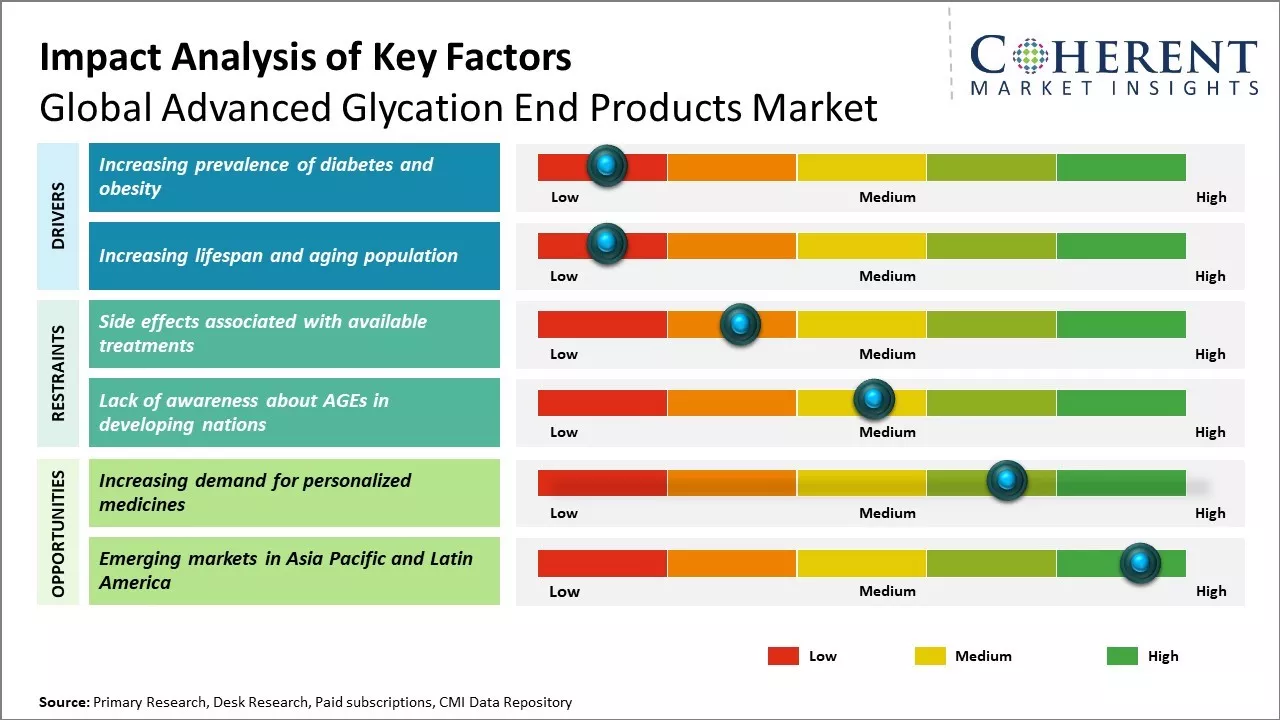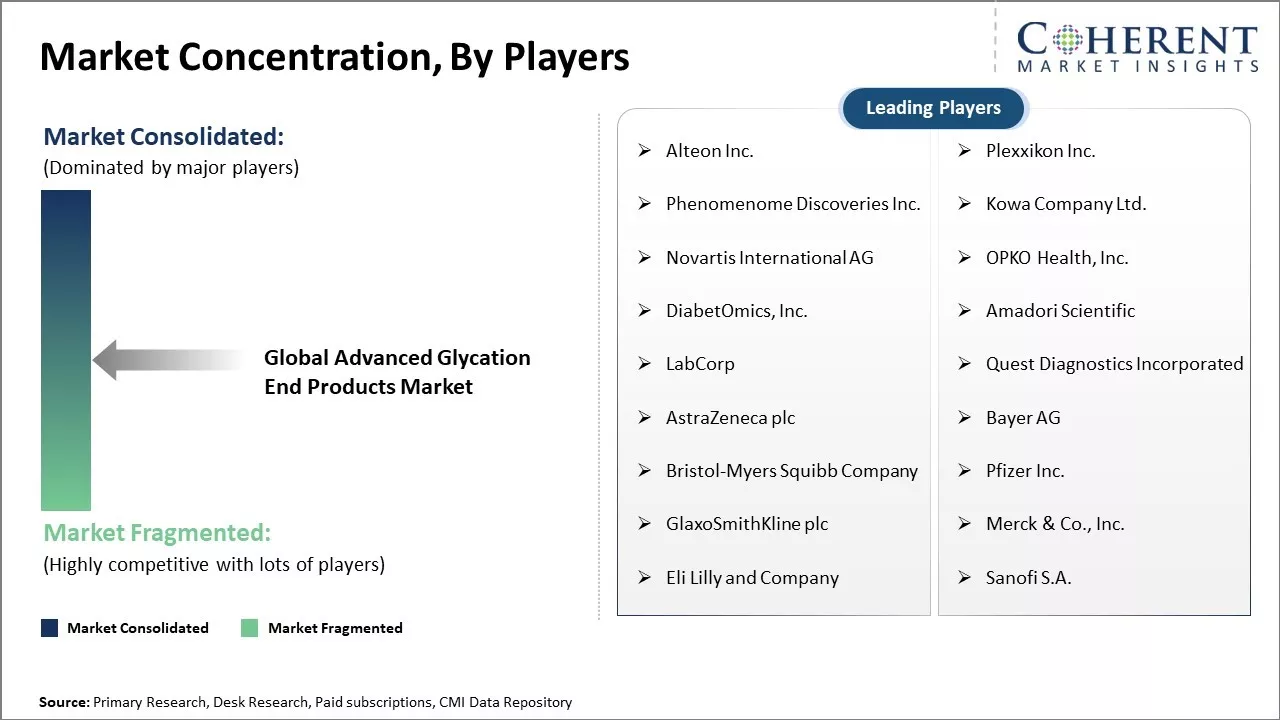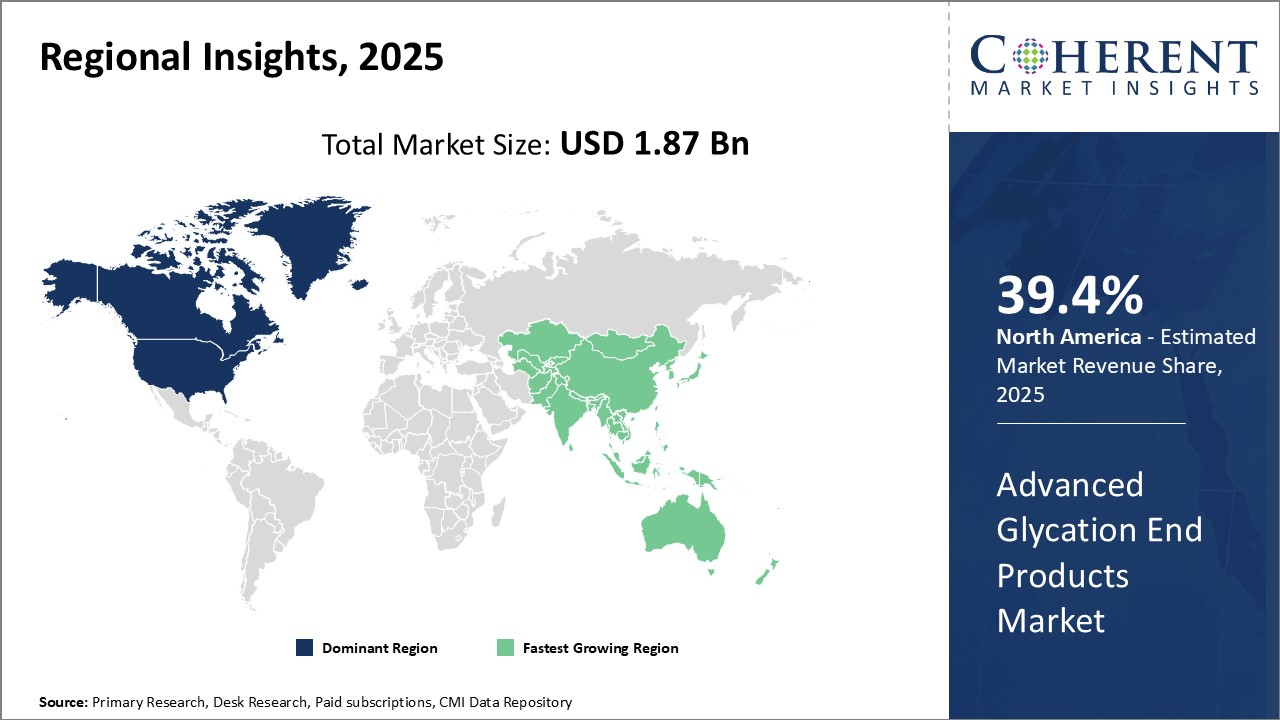Global advanced glycation end products market is estimated to be valued at US$ 1.87 Bn in 2025 and is expected to reach US$ 3.01 Bn by 2032, exhibiting a compound annual growth rate (CAGR) of 7.0% from 2025 to 2032.

Discover market dynamics shaping the industry: Download Free Sample
Rising burden of diabetes and increasing adoption of unhealthy lifestyle habits can drive the market growth. Increasing investment by major market players for the development of novel drugs for the treatment of diabetes-related can also drive the market growth. Furthermore, growing obesity rates worldwide along with increasing geriatric population prone to diabetes and associated co-morbidities can drive the market growth over the forecast period.
Increasing prevalence of diabetes and obesity
Rising prevalence of diabetes and obesity can drive the market growth. Diabetes, in particular type 2 diabetes, is a major risk factor for the development of advanced glycation end products in the body. When blood sugar levels remain elevated for prolonged periods in diabetes, it leads to non-enzymatic glycation of proteins and lipids through a chain of complex chemical reactions. This process of glycation and the subsequent rearrangement of amino acids forms AGEs. Similarly, obesity is a chronic metabolic condition characterized by increased adiposity and insulin resistance, often preceding the onset of type 2 diabetes. The accumulation of excess body fat promotes oxidative stress and inflammation in tissues, two pathogenic processes strongly linked to AGE formation. As per estimates by health organizations, the total number of adults with diabetes had nearly quadrupled worldwide between 1980 to 2014. Rising prevalence of diabetes and obesity contributes to a greater disease burden from AGEs. This boosts demand for anti-AGE therapeutics. For instance, on June 23, 2025, according to the studies presented at the ADA's 84th Scientific Sessions in Orlando, advancements in GLP-1 receptor agonists can treat obesity. These developments come amid increasing concerns as obesity affects 125 million Americans, including 41.9% of adults and 19.7% of children. With 90% of diabetes patients grappling with overweight or obesity, the research aims to provide new solutions globally, according to Dr. Robert Gabbay,chief scientific and medical officer.

Get actionable strategies to beat competition: Download Free Sample
Increasing lifespan and aging population
With significant improvements in public health and modern medicine there has been increase in life expectancy. People are now living longer than before. However, aging is an important risk factor for several chronic and degenerative diseases. As human body grows older, the natural process of AGE accumulation also accelerates due to slower tissue turnover and repair mechanisms. Aged tissues and organs exhibit markedly elevated AGE levels as compared to the young people. Aging is often accompanied by gradual decline in kidney function, which impairs the elimination of AGEs from the circulation. All these age-related changes increase burden of AGE. With growing geriatric population, age-related conditions requiring long-term management also increases. Thus, rising population of elderly individuals can boost use of anti-AGE therapies for the prevention and treatment of accelerated aging and age-related pathologies. New research exploring the pathological effects of AGEs have also drawn scientific and clinical interest in AGE-targeted drug development for different aging populations.
Key Takeaways from Analyst:
Rising incidences of chronic diseases such as diabetes, cardiovascular diseases and renal diseases among aging population can boost demand for anti-AGE products. Anti-AGE agents are increasingly being used to manage chronic conditions and slow down disease progression. Increasing health consciousness and awareness regarding the ill-effects of AGEs accumulation in the body is encouraging consumers to adopt preventive AGE inhibitor therapies.
High costs associated with AGE inhibition treatment options can hamper the market growth. Moreover, limited scientific evidence regarding long term efficacy and safety of some AGE inhibitor therapies can also hamper the market growth. North America currently dominates the market and is expected to continue its dominance, owing to growing elderly population and high healthcare expenditure in the region. Asia Pacific is likely to emerge as the fastest growing market due to rising aging demographics, growing medical tourism and improving access to healthcare in developing nations.
Market Challenges: Side effects associated with available treatments
The side effects associated with available treatments can hamper the global advanced glycation end products market growth. Currently, there are limited treatment options available for managing AGEs and their related health issues. Many of the existing drugs and therapies have undesirable side effects that discourage patients from opting for long-term treatment. Most AGE inhibitors that are prescribed to reverse or slow down the glycation process often interact with other drugs and herbal supplements. This leads to harmful drug-drug interactions in the body. For example, aminoguanidine is one of the early generation AGE inhibitors but was not approved for clinical use due to safety concerns over potential side effects like immunosuppression. ALT-946 (alagebrium) showed promise in clinical trials for reducing heart disease risks in diabetic patients. However, its development was discontinued as it was found to cause adverse reactions like low blood pressure, diarrhea, bone fractures and others.
Market Opportunities: Increasing demand for personalized medicines
Increasing demand for personalized medicines can offer great opportunity for global advanced glycation end products market growth. With rising precision medicine and increased focus on targeting treatment based on an individual's genetic profile and biomarkers, there has been huge demand for personalized diagnostics and therapies tailored to unique patient needs. Advanced techniques for analyzing are especially relevant here as these biomarkers can provide valuable insight into pathological conditions on a patient-specific level. As genetics and molecular biology continue to transform healthcare, AGEs are poised to play an important role in the development of personalized medicines. Certain AGE structures have been shown to correlate with susceptibility to various diseases and treatment responses. Their measurement could help stratify patients and guide clinicians towards optimized therapeutic strategies for each individual. This would represent a paradigm shift away from conventional one-size-fits-all approaches, instead facilitating more precise and targeted clinical decision making. Pharmaceutical companies have taken note and several are actively pursuing R&D efforts to discover novel AGE-modulating drugs with applications in personalized therapies.

Discover high revenue pocket segments and roadmap to it: Download Free Sample
By Type - Factors Proliferating the Growth of Non-fluorescent AGEs
In terms of type, non-fluorescent AGEs segment is estimated to contribute the highest market share of 60.6% in 2025, owing to growing prevalence of diabetes among geriatric population and increasing life expectancy globally. Non-fluorescent AGEs accumulate at a faster rate in tissues of elderly patients and diabetic individuals due to regular glycation of protein and lipids. Moreover, non-fluorescent AGEs induce expression of inflammatory markers like TNF-α and IL-6, which accelerate aging and onset of age-related complications. Furthermore, increasing adoption of sedentary lifestyle and unhealthy diets rich in carbohydrates and fats boosts the risk of developing diabetes. As per studies, diabetic patients have 3-4 times higher levels of non-fluorescent AGEs in their vascular and renal tissues as compared to normal individuals. This has boosted demand for non-fluorescent AGEs testing for effective diabetes management and treatment of associated disorders.
By Application - Diabetic remains the key revenue generator
In terms of application, diabetic segment is estimated to contribute the highest market share of 30.71% in 2025, due to rising prevalence of diabetes worldwide. Elevated levels of AGEs are directly implicated in pathogenesis of diabetes and its ensuing complications like cardiovascular diseases, kidney damage and nerve damage. AGEs bind with receptor for advanced glycation end products (RAGE) and provoke cellular dysfunction in patients with diabetes. This induces oxidative stress and low-grade chronic inflammation in vasculature over the years. As per estimates, around 425 million people are currently living with diabetes and the figure is projected to rise to 629 million by 2045 globally. This has significantly boosted demand for monitoring and inhibiting AGEs levels through targeted therapeutics to manage diabetes symptoms and avoid long-term effects.
By End User: Hospitals dominate the end user landscape
In terms of end user, hospitals segment is estimated to contribute the highest market share of 40.62% in 2025, due to accessibility of advanced diagnostic technologies, availability of skilled healthcare professionals and favorable reimbursement policies in hospital. Hospitals are equipped with high-end AGE reader devices and HPLC machines to accurately quantify different AGE compounds from minimally invasive samples. The presence of diabetes care teams including endocrinologists and nutritionists facilitate comprehensive patient evaluation and management in hospitals. Moreover, government schemes and private insurance plans offer partial to full coverage for AGE testing prescribed by consultants in hospitals. This has increased preference for hospitals among patients for AGE analysis and therapeutic monitoring.

Need a Different Region or Segment? Download Free Sample
North America dominates the global advanced glycation end products market with an estimated market share of 39.4% in 2025. The U.S. accounts for the largest share due to increasing incidence of diabetes and associated conditions. Strong presence of leading medical device and pharmaceutical companies in the region can drive the market growth. The region is an early adopter of new treatment technologies and devices for managing diabetes and its complications.
Availability of favorable reimbursement policies from public and private healthcare payers also drives the market growth. Improved access to healthcare and growing medical expenditures per capita contributes to the widespread adoption of AGE inhibitors and other treatment therapies. Major market players have their headquarters in the region and invest substantially in R&D to develop new and improved products. This has resulted in the U.S. having access to most innovative treatment options before other regions.
Asia Pacific has emerged as the fastest growing regional market over the past few years. Rapid economic development and rising affluence has increased healthcare spending across developing nations. Growing burden of diabetes and related chronic illnesses due to changes in dietary habits and lifestyle patterns can offer market growth opportunities. Rising focus of international players to expand in emerging Asian countries can also drive the market growth.
Advanced Glycation End Products Market Report Coverage
| Report Coverage | Details | ||
|---|---|---|---|
| Base Year: | 2024 | Market Size in 2025: | USD 1.87 Bn |
| Historical Data for: | 2020 To 2024 | Forecast Period: | 2025 To 2032 |
| Forecast Period 2025 to 2032 CAGR: | 7.0% | 2032 Value Projection: | USD 3.01 Bn |
| Geographies covered: |
|
||
| Segments covered: |
|
||
| Companies covered: |
Alteon Inc., Plexxikon Inc., Phenomenome Discoveries Inc., Kowa Company Ltd., Novartis International AG, OPKO Health, Inc., DiabetOmics, Inc., Amadori Scientific, LabCorp, Quest Diagnostics Incorporated, AstraZeneca plc, Bayer AG, Bristol-Myers Squibb Company, Pfizer Inc., GlaxoSmithKline plc, Merck & Co., Inc., Eli Lilly and Company, Sanofi S.A. |
||
| Growth Drivers: |
|
||
| Restraints & Challenges: |
|
||
Uncover macros and micros vetted on 75+ parameters: Get instant access to report
*Definition: Global Advanced Glycation End Products Market consists of products that help reduce the effects of advanced glycation end products (AGEs) in the human body. AGEs are compounds that are known to damage cells and tissues over time. These accumulate as part of the natural aging process and due to poor dietary habits. The products in this market include supplements and creams containing ingredients that prevent AGE formation or help break down existing AGEs. These products aim to slow down signs of aging and lower the risk of age-related diseases.
Share
Share
About Author
Vipul Patil is a dynamic management consultant with 6 years of dedicated experience in the pharmaceutical industry. Known for his analytical acumen and strategic insight, Vipul has successfully partnered with pharmaceutical companies to enhance operational efficiency, cross broader expansion, and navigate the complexities of distribution in markets with high revenue potential.
Missing comfort of reading report in your local language? Find your preferred language :
Transform your Strategy with Exclusive Trending Reports :
Frequently Asked Questions
Joining thousands of companies around the world committed to making the Excellent Business Solutions.
View All Our Clients